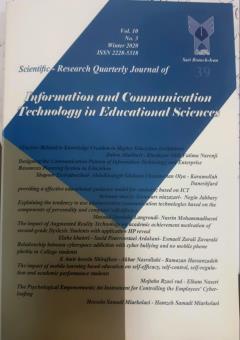مرور سیستماتیک پژوهش های رباتیک در حوزه آموزش: درس هایی از گذشته و مسیرهای آینده
الموضوعات :
1 - گروه علمی، دانشگاه پیام نور، تهران، ایران
الکلمات المفتاحية: آموزش رباتیک, خلاقیت, یادگیری, بررسی سیستماتیک, کتاب سنجی,
ملخص المقالة :
هدف پژوهش حاضر بررسی وضعیت توسعه دانش، شناسایی خوشههای موضوعی اصلی، تحولات مفهومی و بازیگران کلیدی در حوزه رباتیک آموزشی می باشد. روش تحقیق در پژوهش حاضر از حیث هدف کاربردی و از لحاظ روش شناسی پژوهشی کمی است و به روش مرور سیستماتیک انجام شده است. جامعه آماری پژوهش، 248پژوهش پس از انجام غربالگری بین سال های 2010 تا کنون می باشد. برای تجزیه و تحلیل از نرم افزارVOSviewer استفاده شد. بر اساس یافتههای پژوهش در حوزه های اصلی مورد مطالعه در ربات های آموزشی از سال 2010 تا کنون محور های مطالعاتی ربات های آموزشی، فناوری آموزشی و توسعه تفکر محاسباتی، مطالعاتی که به تاثیرات ربات های آموزشی بر روی دانش اموزان و همچنین دانش اموزان استثنائی ، محیط تعاملی، کارایی و بهره وری، دستاوردهای دانشی و برنامه تحصیلی متمرکز بوده است. در مورد تحول زمانی، یافته های پژوهش نشان داد، اولویت ها و موضوعات تحقیق در طول زمان تکامل یافته اند و مفاهیم کلیدی مانند یادگیری، خلاقیت و تاثیرات ربات های آموزش در طول زمان تکرار شده اند. در حوزه همکاری های بین سازمانی نیز یافته های پژوهش نشان داد میزان این همکاری ها بسیار پایین بوده و حوزه مطالعاتی مورد نظر از ادبیات پراکنده ای برخوردار می باشد که بیشتر از از ادبیات علمی امریکا و اتحادیه اروپا تاثیر پذیرفته است. در جمع بندی از یافته های پژوهش می توان اشاره داشت این حوزه مطالعاتی در سال های اخیر رشد پر شتابی داشته و بنظر می رسد در سالهای آتی و با گسترش فناوری های نوین در حوزه رباتیک، و گسترش هوش مصنوعی بیش از پیش مورد توجه رشته های علوم تربیتی و سایر رشته ها و اثرگذار در فرآیندهای آموزشی آنها قرار گیرد.
References
Amriani A, Alham F, Aji AF, Utomo AY, Junus KM. An empirical study of gamification impact on e-Learning environment. Paper presented in the 3rd International Conference on Computer Science and Network Technology, ICCSNT. Dalian, China; 2014.
Barker, B. S., & Ansorge, J. (2007). Robotics as means to increase achievement scores in an informal learning environment. Journal of research on technology in education, 39(3), 229-243.
Bascou, N. A. & Menekse, M. (2016). Robotics in K-12 formal and informal learning environments: A review of literature. Paper presented at the 2016 ASEE Annual Conference & Exposition, New Orleans, Louisiana.
Bouvier, S., & Connors, K. (2011). Increasing student interest in science, technology, engineering, and math (STEM). America: Massachusetts Department of Higher Education publication.
Burgo Bencomo, O. B., León González, J. L., Cáceres Mesa, M. L., Pérez Maya, C. J., & Espinoza Freire, E. E. (2019). Algunas reflexiones sobre investigación e intervención educativa. Revista Cubana de Medicina Militar, 48.
Buitrago Flórez, F., Casallas, R., Hernández, M., Reyes, A., Restrepo, S., & Danies, G. (2017). Changing a generation’s way of thinking: Teaching computational thinking through programming. Review of Educational Research, 87(4), 834-860.
Conchinha, C., Silva, S. G., & Freitas, J. C. (2015). La robótica educativa en contexto inclusivo. Ubicuo social: Aprendizage con TIC.
Chang, C. W., Lee, J. H., Chao, P. Y., Wang, C. Y., & Chen, G. D. (2010). Exploring the possibility of using humanoid robots as instructional tools for teaching a second language in primary school. Educational Technology & Society, 13(2), 13-24.
Damaševičius, R., Maskeliūnas, R., & Blažauskas, T. (2018). Faster pedagogical framework for steam education based on educational robotics. International Journal of Engineering and Technology, 7(2.28), 138-142.
Domínguez, A., & Stipcich, M. S. (2018). Trabajo colaborativo y TIC para ayudar a un estudiante con TDA* a aprender física. Revista de enseñanza de la física, 30(1), 53-61
Funk, M., Cascalho, J., Santos, A. I., Pedro, F., Medeiros, P., Amaral, B., & Mendes, A. (2022). A simple interactive robot to promote computational thinking. Frontiers in Computer Science, 4, 1-13.
Frangou, S., Papanikolaou, K., Aravecchia, L., Montel, L., Ionita, S., Arlegui, J., Pina, A., Menegatti, E., Moro, M., Fava, N., Monfalcon, S., & Pagello, I. (2008). Representative examples of implementing educational robotics in school based on the constructivist approach. Conference on simulation modeling and programing for autonomous robots Venice (Italy) (pp. 54–65)
Fülöp, M. T., Udvaros, J., Gubán, Á., & Sándor, Á. (2022). Development of computational thinking using microcontrollers integrated into OOP (Object-Oriented Programming). Sustainability, 14(12), 7218.
Han, J., Jo, M., Jones, J., & Jo, J. H. (2008). Comparative study on the educational use of home robots for children. Journal of Information Processing Systems, 4(4), 159–168.
Karami, M., Rajaei, M., & Naamkhaah, M. (2014). Investigation of tendency toward critical thinking in secondary school teacher and its role on their teaching style. Research In Curriculum Planning, 11(13), 34–47. [In Persian]. http://jsr-e.khuisf.ac.ir/article_534314_en.html. Accessed 15 December 2017
Lough, T., & Fett, C. (2002). Robotics education: Teacher observations of the effect on student attitudes and learning. The Magazine of Design & Technology Education. https://www.researchgate.net/publication/266661041. Accessed 11 July 2019.
Pozzi, M., Prattichizzo, D., & Malvezzi, M. (2021). Accessible educational resources for teaching and learning robotics. Robotics, 10(1), 38.
Roosta F, Taghiyareh F, Mosharra, M. Personalization of gamification-elements in an e-learning environment based on learners' motivation. Paper presented in 8th International Symposium on Telecommunications, IST 2016. Tehran, Iran; 2017.
Urias MDV, Chust AC, Carrasco OL. How to gamify an online technical subject in higher education. In L.G. Chova, A.L. Martinez, and I.C. Torres (Eds.). In Proc. of Edulearn16: 8th International Conference on Education and New Learning Technologies (pp. 7071-708). Barcelona, Spain; 2016.
Santos, I., Grebogy, E. C., & Medeiros, L. F. D. (2019). Crab robot: a comparative study regarding the use of robotics in STEM education. In Smart Learning with Educational Robotics (pp. 183-198). Springer, Cham.
Yanış, H., & Yürük, N. (2020). Development, validity, and reliability of an educational robotics based technological pedagogical content knowledge self-efficacy scale. Journal of Research on Technology in Education, 53(4), 375-403.


